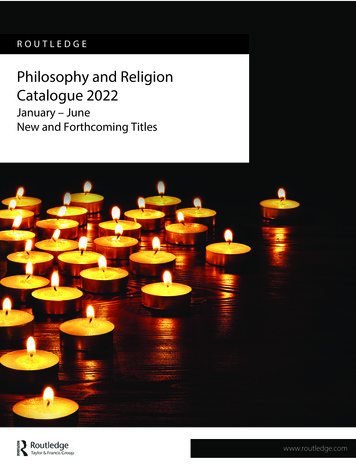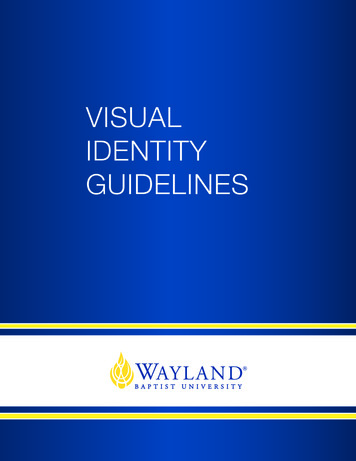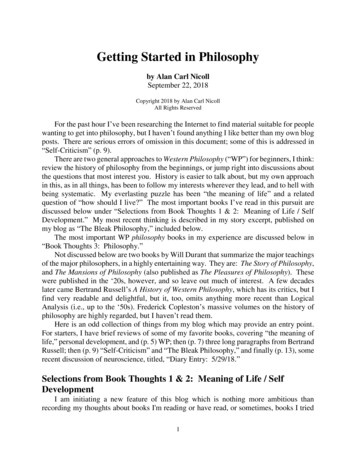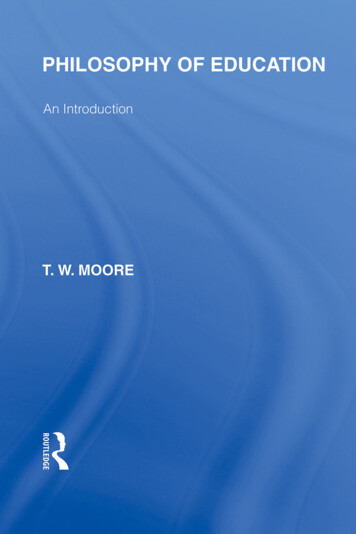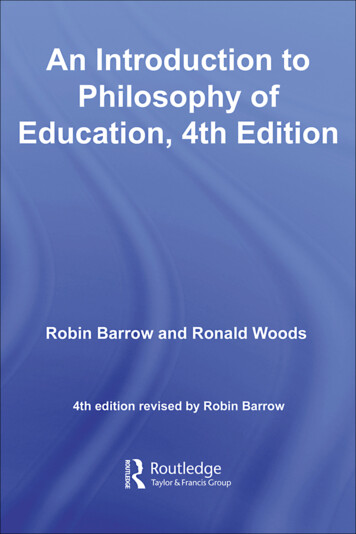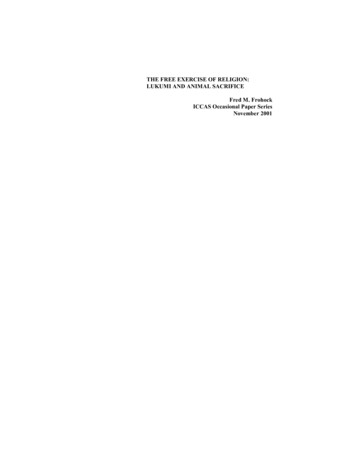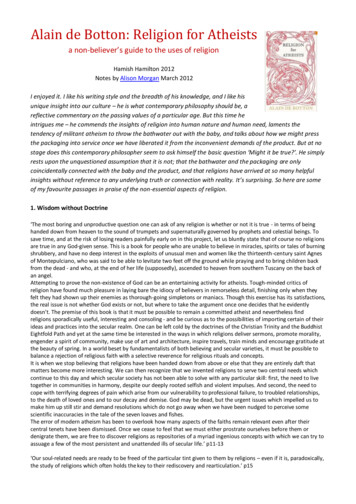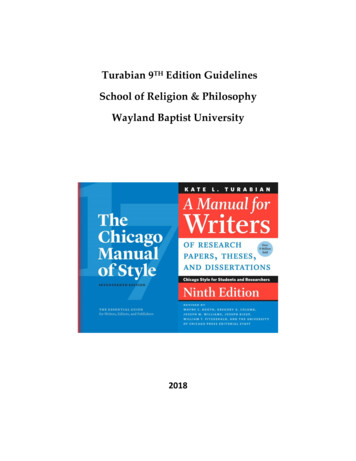
Transcription
Turabian 9TH Edition GuidelinesSchool of Religion & PhilosophyWayland Baptist University2018
2Turabian StyleThe School of Religion and Philosophy uses Turabian 9th edition as a style guide for all papersand research projects. You will need to purchase this book to understand these guidelines.Purchasing InformationKate L. Turabian. A Manual for Writers of Research Papers, Theses and Dissertations: ChicagoStyle for Students and Researchers, 9th Edition. Chicago: The University of Chicago Press, 2018.ISBN: 13: 978-0-226-49442-5 (cloth)ISBN: 13: 978-0-226-43057-7 (paper)ISBN: 13: 978-0-226-43060-7 (e-book)Who was Kate Turabian?“Kate Larimore Turabian (1893–1987) was the graduate school dissertation secretary atthe University of Chicago for nearly three decades, from 1930 to 1958. She was also theeditor of official publications for the university.Born and raised on Chicago’s South Side, Laura Kate Larimore graduated from HydePark High School. When a serious illness prevented her from attending college, she tooka job as a typist at an advertising agency, where she worked alongside a young SherwoodAnderson.Kate Larimore met her husband, Stephen Turabian, in 1919 and began working at theuniversity as a departmental secretary a few years later. In 1930 she became theuniversity’s dissertation secretary, a newly created position in which every accepteddoctoral thesis had to cross her desk. It was there in 1937 that she wrote a smallpamphlet describing the university’s required style for writing college dissertations.That pamphlet eventually became A Manual for Writers and has gone on to sell morethan nine million copies in nine editions. Turabian also authored The Student’s Guidefor Writing College Papers.Turabian’s 1937 booklet reflected guidelines found in the tenth edition of The ChicagoManual of Style—an already classic resource for writers and editors published by theUniversity of Chicago Press (now in its seventeenth edition). The Press begandistributing Turabian’s booklet in 1947 and first published it in book form in 1955 underthe title A Manual for Writers of Term Papers, Theses, and Dissertations. Over time,Turabian’s book has become a standard reference for students of all levels at universitiesand colleges across the country. Turabian died in 1987 at age ninety-four, a few monthsafter publication of the book’s fifth edition.” (History of Kate Turabian’s A Manual forWriters University of Chicago Press, accessed August 21 /about/history.html).
3Turabian and Chicago StyleThe Turabian Manual is a detailed guide to using Chicago Style. The ChicagoStyle Manual is expensive and over 1000 pages. Many schools require students to useTurabian rather than the full Chicago Style because of its relative brevity and ease ofuse.Turabian OverviewTurabian is organized in three parts with an appendix. Part 1 provides guidelinesfor research and writing. This is an excellent student guide and something every studentshould read; however, this guide will focus on parts two, three, and the appendix.Part 2 provides guidelines for citing the sources of the information you use inyour paper. Chapter 16 gives the basic form of the notes-bibliography style, and chapter17 gives examples for citing specific types of sources. These two chapters are central tounderstanding the requirements for your paper.Chapters 18 and 19 are concerned with the author-date style of citation.Because the School of Religion and Philosophy requires notes-bibliography style, donot use the guidelines in these chapters.Part 3 has to do with general style. It covers spelling, punctuation, names, specialterms, titles of works, numbers, abbreviations, quotations and tables and figures.The appendix covers general formatting requirements.School of Religion and Philosophy RequirementsSeveral sections of Turabian provide options for formatting depending on therequirement of the school using this style. This section provides the specificrequirements of the School of Religion and Philosophy.LengthThe length of papers does not include the cover page, appendices, orbibliography. Most professors will provide specifications for the length of the paper. Ingeneral it is 2500 to 4000 words for undergraduate students and 5000 to 7000 wordsfor graduate students.Notes-Bibliography StylePapers and projects must use the notes-bibliography style of citation (seechapters 17 and 18). Turabian provides two options within this style, endnotes andfootnotes. Papers in the School of Religion and Philosophy must use footnotes.General FormattingMargins A.1.1Leave a margin of 1 inch on all four edges of the page.Typeface A.1.2Choose a readable typeface (also called font) such as Times New Roman, Courier New,or Helvetica. Avoid ornamental typefaces. All text size should be 12 pointSpacing and Indentation A.1.3Double space all text except block quotations, footnotes, and bibliography pages. Indentall paragraphs one tab (For additional guidelines, see section 25.2.2, and A.2.1).
4Pagination A.1.4Number all pages with Arabic numerals starting on the first page of text (number 2counting the title page). Do not number the title page. Page numbers should be placedflush right in the header (at the top of the page).Title PageFollow the example on page 391 (Figure A.1).Sections and SubsectionsFollow the guidelines given in section A.2.2.4 on page 404.Varying Course RequirementsIt is your responsibility to review the guidelines set by each professor before yousubmit any assignments. Guidelines set by professors always take precedence over theguidance provided here.
5Turabian 9th Edition Format ChecklistEach item on the checklist is followed by the Turabian section number describing theformatting requirements.General Formatting1. 1 inch margins on the right, left, top and bottom sides of each page of themanuscript A.1.12. The font is the correct size and style: A readable font such as Times New Roman orArial. Use the at least ten-point Arial or 12-point Times New Roman for the body of thetext A.1.23. The manuscript is double-spaced throughout with exceptions listed in rule A.1.34. The title page is not numbered, and each following page numbers beginning withthe number 2 are at the top of the page, and flush right. A.1.45. There is only one space after punctuation marks including commas, colons,semicolons, punctuation at the end of sentences, periods in citations, and all periods inthe References section A.1.36. Arabic numerals in parentheses have been used to indicate a series of events oritems within a paragraph 23.4.2.17. Words are not broken (hyphenated) at the end of a line 20.4.18. All units of measurement are spelled out fully 24.59. Arabic numerals have been used correctly to express:a. numbers are fully spelled out from one to one-hundred 23.1.1b. numbers that immediately precede a unit of measurement 23.1.1c. numbers that represent fractions and percentages 23.1.3d. numbers that represent times, dates, ages, participants, samples, populations,scores, or points on a scale 23.1.1, 23.1.510. The Bible and other sacred works are:a. Not listed in the bibliography 16.2.3, 17.8.2b. When citing names of whole books or chapters of the Bible, Apocrypha, orQur’an, they are spelled out fully in the text of the paper, but not italicized 24.6c. Biblical passages are cited by verse (see 17.8.2 and 19.8.2)d. Names of numbered books are numbered using Arabic numerals (1 Kings) 24.6e. Arabic numbers are used to indicate chapter and verse with a colon betweenthem. 24.6f. Versions of the Bible cited is identified 24.6
6g. Name of the version is spelled out on the first occurrence or use standardabbreviations 24.6.4h. Standard abbreviations are used for all books of the Bible 24.6.1, 24.6.2, 24.6.311. Dates and Eras (e.g. BCE, CE) are listed correctly 24.4.1, 24.4.2, 24.4.3Introduction, Background, Body, Summary and Conclusion12. The term “Introduction” appears at the top of the first page of the body A.2.2.113. Paragraphs are structured properly 9.414. Quotations are word-for-word accurate 25.115. Page numbers are provided for sources that are summarized, paraphrased, andquoted or from which ideas are taken 15.3.116. Terms that are abbreviated are written out completely the first time they are used,then always abbreviated thereafter 24.1.217. Latin abbreviations are used sparingly and only in parenthetical material 24.718. Each citation used in the manuscript is correctly typed in the References section16.2Footnotes19. The phrase et al. is used with each footnote that lists four or more authors 16.1 #2page 15220. “Ibid.” is used correctly 16.4.221. Footnotes are separated by a blank line 16.3.4.122. The footnote separator line (rule) goes directly to the bottom of the text 16.3.4.123. Each footnote is single-spaced 16.3.4.124. Each footnote is indented like a paragraph 16.3.4.125. Each footnote follows correct Turabian 9th edition format (See chapter 17)
7Bibliography26. Each bibliographic reference follows correct Turabian form (See chapter 17)27. All entries are in alphabetical order 16.2.2.128. Every entry occurs in the body of the manuscript 16.229. Authors’ names are separated by commas 16.2.2.130. The volume numbers of journal[s] are not italicized 17.1.431. Each entry is typed in a “hanging indent” format, meaning that the first line of eachreference is typed flush left and every line after the first line of each entry is indented16.1.732. The names of journals, book chapters, and books are correctly capitalized 16.1.333. Each reference is single spaced (See Figure A.15)34. References are double spaced between each entry (See Figure A.15)35. Authors who have written multiple sources are arranged by date or by work 16.2.2.1
The Death Penalty: A Christian PerspectiveKelli WalkerRSWR 3345: Research Writing MethodsMay 14, 2011
1The Death Penalty: A Christian PerspectiveIntroductionFew topics are more controversial than the death penalty. Recent statistics show that 64percent of Americans are in favor of the death penalty for a person convicted of murder, while 29percent are opposed.1 Additionally, polls have shown that a majority of religious persons are infavor of the death penalty;2 but several Christian denominations are ardently opposed.3 Bothsides of the debate have people pointing to the Bible as the source of their opinion. A number ofproof texts are offered—some of the most familiar being the “eye for an eye” passages fromExodus 21:23-24 and Leviticus 24:20—as well as the first lines of Genesis 9:6 declaring“whoever sheds human blood, by humans shall their blood be shed.” These passages arecountered by Jesus’ directive in Matthew 5:39 to “turn the other cheek,” or his offer to thePharisees in John 8:7 to “let him who is without sin cast the first stone.” This begs the question:is capital punishment defensible from a Christian standpoint?Brief History of Capital Punishment in the United StatesThe death penalty has been a part of the American justice system since the initial settlersarrived from Europe. The first known execution was in 1608, when Captain George Kendall was1. Gallup, “In U.S., 64% Support Death Penalty in Cases of Murder,” accessed May3,2011 http://www.gallup.com/poll/ 144284/Support-Death-Penalty-Cases-Murder.aspx.2. Sourcebook of Criminal Justice Statistics Online, accessed May 3, 2011,http://www.albany.edu/sourcebook/pdf/ t200372010.pdf.3. Gardner C. Hanks, Capital Punishment and the Bible (Scottsdale, AZ: Herald Press,2002), 14-15
2hanged for being a spy for Spain. This public punishment was common in Britain, andsubsequently adopted by the new colonists as a way to maintain order in society.4A century and a half later, the abolitionist movement began, sparked by the writings ofseveral European philosophers and Quakers who considered the death penalty morally wrong.None were more influential than Cesare Beccaria, author of On Crimes and Punishment in 1764.In his famous essay, Beccaria posited that the state had no right to take a human life. Thisconcept resonated with intellectuals, and political leaders of the time and led to reforms. Most ofthese reforms resulted in reductions in the number of capital crimes.5Over the next two hundred years, the states revisited their capital laws and methods ofexecution, approaching them from a more sociological perspective. They adopted goals ofprotecting society, rehabilitating criminals, and using more humane methods of punishment.Executions were no longer public spectacles in the town square, but administered by stateprofessionals in mostly closed environment.6 A number of states completely abolished the death8penalty.7 The Supreme Court decision in Furman v. Georgia , found many federal and statecapital punishments laws “arbitrary and capricious,” and that they constituted cruel and unusual4. Hugo Adam Bedau and Paul G. Cassell, eds., Debating the Death Penalty: ShouldAmerica Have Capital Punishment? The Experts on Both Sides Make Their Best Case (Oxford:University Press, 2004), 15-16.5. Death Penalty Information Center, Introduction to the Death Penalty, accessed May3,2011, http://www.death 6. Ibid.7. H. Wayne House and John Howard Yoder, The Death Penalty Debate (Dallas, TX:Word Publishing, 1991), 16.8. Furman v. Georgia, 408 U.S. 153 (1972).
39punishment in violation of the Eighth Amendment to the U.S. Constitution, as well violating the10due process guarantees of the Fourteenth Amendment . Of the people sentenced to thepunishment by death, only a small percentage were actually being executed, and the decision wasoften racially biased.11 As a result, states put new processes in place to attempt to solve the unfairapplication of the death penalty, and in 1977 the death penalty was reinstated.12According to the latest Bureau of Justice statistics, 36 states and the Federal Bureau ofPrisons hold over 3,000 inmates sentenced to death.13 While many of these cases gain littleattention on a national level, criminals like Timothy McVeigh, John Lee Malvo, and Ted Bundycause Americans to pay attention and attempt to clarify their thoughts on the matter. ForChristians, the issue is more than just social or philosophical. It is beyond the realm of statisticsand politics. It is a clash between obedience to God and an obligation to show mercy to theirfellow man.Death Penalty ProponentsThe Sixth Commandment declares, “You shall not murder.” This instruction clearlyshows God’s disapproval of the premeditated taking of human life by another. Christian9. U.S. Const. amend. VIII.10. U.S. Const. amend. XIV, §1.11. House, 16.12. John S. Feinberg, Paul D. Feinberg and Aldous Huxley, Ethics for a Brave NewWorld (Wheaton, IL: Crossway Books, 1996), 127.13. Bureau of Justice Statistics, “Capital Punishment—2009 Statistical Tables,” accessedMay 3, 2011, http://bjs.ojp. usdoj.gov/index.cfm?ty pbdetail&iid 2215.
4proponents of the death penalty believe the Bible gives proper guidance on the just punishmentfor this serious offense.A number of justifications are commonly given as the basis for the proponents’ position.Some are objectives shared with secular society, such as deterrence of crime and protection ofsociety from physical harm, but most reasons are taken straight from the Scriptures.Foundational to their argument is the belief supported by Genesis 9:6, that mankind is made inthe image of God – the imago Dei.Imago DeiGenesis 9:6 contains words from God’s everlasting covenant with Noah, given after thegreat flood. It states, “Whoever sheds human blood, by humans shall their blood be shed; for inthe image of God has God made man.” For the Christian proponent, these words are timelesstruths that apply to all mankind, since man continues to bear the imago Dei today.14 Because ofthis unique status as God’s representative, the highest value is placed on human life. Only Godhas the authority to determine when life will end. When a human is murdered, the murdererdefiantly assumes God’s role, and in essence, God is offended.15 For the Christian proponent ofthe death penalty, the appropriate punishment for this offense is one that equals the harm done –a concept known as lex talionis or law of retribution.1614. House, 45.15. Ron Gleason, The Death Penalty on Trial (Ventura, CA: Nordskog, 2008), 26.16. John F. Walvoord, Roy B. Zuck and Dallas Theological Seminary, The BibleKnowledge Commentary: An Exposition of the Scriptures (Wheaton. IL: Victor Books, 1983);Lev. 24:13-22.
5RetributionRetribution is the act of repaying. It is often used in the context of crimes andpunishment, and it is a concept found throughout the Bible.17 An “eye for an eye” is probably themost recognizable biblical saying regarding the death penalty. This familiar phrase is found inthe Old Testament passages of Exodus 21:23-25, Leviticus 24:17-20, and Deuteronomy 19:1821. While the provision allows for equal damage as the punishment for the damage done, it doesnot allow for punishment beyond that harm. It places a limit on the amount of retaliation orrevenge that can be exacted. If an eye was injured, then only an eye could be injured in return nomore.18 Those who favor the death penalty believe the life of the murderer is the suitablepayment for the crime committed.Government DutyIn addition to emphasizing the value of human life, Genesis 9:6 also establishes thebeginnings of human government. Martin Luther observed:Here we have the source from which stem all civil law and the law of nations. IfGod grants to man power over life and death, surely he also grants power overwhat is less If God had not conferred this divine power on men, what sort oflife do you suppose we would be living? Because he foresaw that there would bealways a great abundance of evil men, He established this outward remedy inorder that wantonness might not increase beyond measure. With this hedge, thesewalls, God has given protection for our life and our possessions.19This Scripture, taken together with the New Testament passage of Romans17. House, 20.18. Hanks, 68-69.19. Martin Luther, “Lectures in Genesis,” in Luther’s Works, vol. 2, ed. Jaroslav Pelikan,(Saint Louis, MO: Concordia Publishing House, 1986), 140-41.
613:1-4, builds support for the government’s duty to punish by means of the death penalty. InRomans 13:1-4, the Apostle Paul begins by explaining the Christian’s responsibility to submit tothe governing authorities, as they are authorities established by God. He proceeds to explain theneed for those authorities to maintain peace and execute justice. Verse 4 states: “For the one inauthority is God’s servant for your good. But if you do wrong, be afraid, for rulers do not bearthe sword for no reason. They are God’s servants, agents of wrath to bring punishment on thewrongdoer.” The sword has been interpreted as an instrument of death and a means ofexecution.20Death Penalty OpponentsChristians who oppose the death penalty believe it contradicts the New Testamentteachings of Jesus Christ. They seek the reform of the offender, as well as his spiritualredemption. Like the proponents, they also believe that only God holds the authority to end thelife of another human being.Teachings of Jesus ChristIn all of his teachings, Jesus never gave a direct statement on capital punishment. Instead,he modeled the way Christians are to conduct their lives and he taught them to think with themind of Christ. Opponents in the debate stress the significance of the Law of Christ, which islove. They point to the commonly quoted Scriptures of John 8:7, Matthew 5:39, and 1 Peter 3:9,as examples of Jesus’ reaction to questions regarding retribution and capital offenses.2120. Gleason, 47.21. Steffen Losel, “Fighting for Human Dignity: A Christian Vision for PunishmentReform,” Political Theology 11, no. 2 (2010): 189.
7In John 8:1-11, a woman accused of adultery was brought to Jesus by Jewish leaders. Atthat time, adultery was a capital offense under Jewish law and death was to be by stoning. Whenasked for his opinion on the matter, Jesus simply replied, “let him who is without sin cast thefirst stone.”22 As none of the accusers qualified for the duty, the woman’s life was spared andJesus did not condemn her. In this succinct statement, Jesus demonstrated not only the fallibilityof those charged with applying the death penalty, but also his willingness to forgive the woman.Matthew 5:38-39 examines the “eye for an eye” principle from a different perspective.Jesus recalls the Old Testament Scripture saying, “You have heard that it was said, ‘eye for eyeand tooth for tooth.’ But I tell you, do not resist an evil person. If anyone slaps you on the rightcheek, turn to them the other cheek also.” 1 Peter 3:9 follows this same pattern, stating, “Do notrepay evil with evil or insult with insult. On the contrary, repay evil with blessing ” Thesecommands lead opponents to believe that Jesus firmly rejected the idea of retribution, and callsfor reconciliation and forgiveness.23ReformWhen retribution is no longer the goal in punishment, reform or reconciliation to societybecomes the focus. For Christians, the goal for reform necessarily includes repentance andspiritual redemption. Opponents argue that only God knows when a life should end; therefore,execution by humans denies the offender every last opportunity to repent and receive eternallife.2422. John 8:7.23. Stephen B. Chapman, “Reading the Bible as Witness: Divine Retribution in the OldTestament,” Perspectives in Religious Studies 31, no. 2 (2004): 177.24. Losel, 187-88.
8Imago DeiThe image of God in mankind exists despite the presence of sin. God grants this status toall humans and it is “unforfeitable, unrelinquishable and indestructible.”25 Because of the highvalue placed on all mankind, opponents of the death penalty believe that every life – even themost heinous criminal’s – is precious to God and worthy of his love.26Analysis of the ArgumentWhen comparing the arguments of both sides of the death penalty debate, it is importantto begin by recognizing that both acknowledge there are problems with the “the death penalty” isin the United States. They agree that race and income level often influence the outcome ofsentencing, and they are aware that innocent persons have been executed.27 Prior to the SupremeCourt decision in Furman, statistics clearly showed the death penalty being applied in adiscriminatory manner. Subsequent to attempts at reform, and its reinstatement in 1977,discriminatory practices continue to be a concern. As recently as 2000, Illinois governor GeorgeRyan issued a moratorium on executions in his state after 13 men on death row were foundinnocent.28 Despite the problems, those who favor the death penalty argue that the punishment isnot wrong per se, the system just needs to be fixed.29 By recognizing that problems exist –25. Nico Vorster, “The Value of Human Life: Contradictions and Inconsistencies in theDebate, and an Evangelical Response,” The Ecumenical Review 59, no. 2-3 (April-July 2007):371.26. P.C. Enniss, “Presbyterians Oppose Capital Punishment: Galatians 3:24-29,” Journalfor Preachers 25, no. 2 (Lent 2002), 31.27. Hanks, 120.28. Ballard, 483.29. Feinberg, 136.
9problems that can result in the taking of an innocent life – and continuing to support the deathpenalty in America, proponents contradict themselves on the issue of imago Dei.Lex Talionis prescribes an “eye for an eye” system of repayment, a way ofensuring the punishment fits the offense and does not exceed it. Opponents of the death penaltybelieve offenders should be punished for their crimes; however, they believe just punishment canbe imposed using less than the maximum penalty allowed. While an argument can be made thatthe Bible allows the death penalty, it does not require it. In the Old Testament, stringentconditions had to be met before death could be ordered. In fact, the system was set up so thatvery few were actually put to death. There needed to be two eyewitnesses to the crime, and bothhad to make efforts to stop the accused from carrying out the act.30 This was a much higherstandard than the “reasonable doubt” standard applied in criminal cases in America today.Several Old Testament stories show instances when people committed crimes thatcalled for death, but God showed mercy instead. The stories of Cain, Moses, and David are a fewexamples of God’s mercy. In the New Testament, Jesus demonstrated through his own actionsthat his preference was for lesser punishments. In following Jesus’ example, opponents of thedeath penalty suggest the just retribution required of a person who commits murder should belife imprisonment.31Romans 13:1-4 presents some contextual and interpretive problems that must beaddressed before reaching a conclusion on the appropriate role of the government in carrying out30. An Orthodox Jewish Rabbi [pseud.], The Triumph of Justice (Fort Mill, SC:Morningstar Publications, Inc., 2008), 18-20.31. Hanks, 112.
10the death penalty. In this passage, the Apostle Paul is addressing the Roman church at a specifictime of persecution by the Roman government. He issues these words of caution to keep theChristians from revolting against the government, thus keeping the church from beingdestroyed.32 He does not directly address the issue of capital punishment at all. While the swordis likely a reference to the government’s authority to punish, it does not clearly indicate thatpunishment is to be by execution. Machaira, the Greek word used in Romans 13:4, means ashort sword worn on the belt: a dagger. It is not the type of sword that would be used fordecapitation.33 Also, in Rome at that time, executions were carried out by crucifixion, not bysword.34 The sword is likely a metaphor for police powers.35In America, government authority is derived from the consent of the governed.36Therefore, the existence of laws is influenced by citizens. While the death penalty is legal in theUnited States, it is not required to be used. The Old Testament laws established standards forsociety for a particular period of time, but Jesus set different standards. His goals were not tochange the laws, but to change the hearts of individuals and society. As citizens’ hearts change,the ways in which laws are written and enforced can be expected to change. Marshall writes,“The first Christians experienced in Christ and lived out their faith communities anunderstanding of justice as a power that heals, restores, and reconciles rather than hurts,32. Ibid. 203-04.33. House, 146.34. Feinberg, 140.35. Joseph Bottum, “Christians and the Death Penalty,” First Things, no. 155(August/September 2005): 20.36. The Declaration of Independence.
11punishes, and kills, and that this reality ought to shape and direct a Christian contribution to thecriminal justice debate today.”37ConclusionWhile there may be Biblical arguments for the death penalty, there are flaws with thosearguments that call their validity into question. Concurrently, there are strong arguments thatChrist’s example and teaching would call his followers to approach the issue with mercy ratherthan retribution as the highest priority. If the argument for the death penalty is not clearly andirrefutably in favor, it seems imprudent for a follower of Jesus to advocate for it.37. Christopher Marshall, Beyond Retribution: A New Testament Vision for Justice,Crime, and Punishment (Grand Rapids, MI: Eerdmans, 2001), 33.
12BibliographyAn Orthodox Jewish Rabbi [pseud.]. The Triumph of Justice. Fort Mill, SC: MorningStarPublications, Inc., 2008.Ballard, Bruce W. “The Death Penalty: God’s Timeless Standard for the Nations?” Journal ofthe Evangelical Theological Society 43, no. 3 (September 2000): 471-87.Bedau, Hugo and Paul Cassell, eds. Debating the Death Penalty: Should America Have CapitalPunishment? The Experts on Both Sides Make Their Best Case. New York, NY: OxfordUniversity Press, 2004.Bottum, Joseph. “Christians and the Death Penalty.” First Things, no. 155 (August/September2005): 17-21.Bureau of Justice Statistics. “Capital Punishment—2009 Statistical Tables.” NCJ 231676.Accessed May 3, 2011. http://bjs.ojp. usdoj.gov/index.cfm?ty pbdetail&iid 2215.Chapman, Stephen B. “Reading the Bible as Witness: Divine Retribution in the Old Testament.”Perspectives in Religious Studies 31, no.2 (2004): 171-90.Death Penalty Information Center. “Introduction to the Death Penalty.” Accessed May 3, 2011.http://www.death Enniss, P.C. “Presbyterians Oppose Capital Punishment: Galatians 3:24-29.” Journal forPreachers 25, no. 2 (Lent 2002): 29-34.Feinberg, John S., Paul D. Feinberg and Aldous Huxley. Ethics for a Brave New World.Wheaton, IL: Crossway Books, 1996.Gallup. “In U.S., 64% Support Death Penalty in Cases of Murder.” Accessed May 3, 2011.http://www.gallup.com/poll/ ason, Ron. The Death Penalty on Trial: Taking a Life for a Life Taken. Ventura, CA:Nordskok Publishing, 2008.Hanks, Gardner C. Capital Punishment and the Bible. Scottsdale, AZ: Herald Press, 2002.House, H. Wayne, and John Howard Yoder. The Death Penalty Debate. Dallas, TX: Word, 1991.Losel, Steffen. “Fighting for Human Dignity: A Christian Vision for Punishment Reform.”Political Theology 11, no. 2 (2010): 179-204.Luther, Martin. “Lectures in Genesis.” In Luther’s Works. Vol. 2 ed. Jaroslav Pelikan. St. Louis,MO: Concordia Publishing House, 1986.
13Marshall, Christopher D. Beyond Retribution: A New Testament Vision for Justice, Crime, andPunishment. Grand Rapids, MI: Eerdmans, 2001.Sourcebook of Criminal Justice Statistics Online. Accessed May 3, 2011.http://www.albany.edu/sourcebook/pdf/ t200372010.pdf.Vorster, Nico. “The Value of Human L
Manual of Style—an already classic resource for writers and editors published by the University of Chicago Press (now in its seventeenth edition). The Press began distributing Turabian’s booklet in 1947 and first published it in book form in 1955 under the title A Manual for Writers

